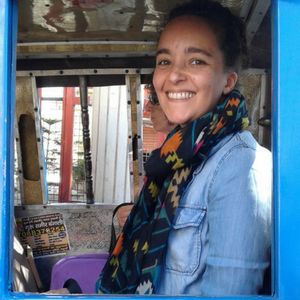
Today is the fourth International Day of Yoga—June 21 was proclaimed as such by the United Nations in 2014. As noted on the UN site about this day, the purpose is to “raise awareness about the benefits of practicing yoga.” The 2018 theme is “Yoga for Peace.” Who would argue for less peace in the world (that’d be nuts!)? I sure wouldn’t. Yet I think this phrase deserves some critical discussion.
But first, for self-reflective honesty, I should tell you about my motivations. I’ve been developing a home yoga practice for about 10 years and teaching small community classes for 7 or so years. And you know what? I can’t bring my nose to my knees in uttanasana, which in some circles means I haven’t accomplished much in all this time. A small part of this “failure” has to do with physical limitations, but mostly I simply don’t care whether I can reach the “full expression of the pose,” as I’ve heard myself and other asana teachers say. The point of yoga for me isn’t about the poses, even though practicing the poses really helps my physical, mental, and spiritual well-being.
Despite having a home practice, where it’s just me doing my thing in a comfy old pair of sweatpants, I find it really hard not to conjure up images of people in fancy Lycra twisting themselves like pretzels when I think of the word “yoga.” What associations come up for you?
What is Peace?
When we think about “yoga for peace,” we have to think about the effects these images have on our understandings of peace, and what makes peace possible. To get to peace in yoga, we must work past the saccharine references in glossy images. We can’t down-dog our way to peace, no matter how many 90-minute vinyasa classes we might fit in the week. I feel great after an asana practice. But that feeling is temporary, and just a feeling. Real peace comes from the practice of, well, peace—even when we feel angry or scared or incapable of challenging inhumane forms of power. Which goes far beyond sticky mats and chanting om.
For this Yoga Day, I invite you to join me in discerning what peace is and how we achieve it. Below I share 6 resources that make me go “WOW,” plus a short yoga-inspired relaxation practice that I created for the Metta Center’s Certificate in Nonviolence Studies course (feeling good in the body absolutely matters; if our nervous systems are haywire, our minds will be haywire too).
1. The Problem With Wanting Peace in Baltimore
Kazu Haga gets down to (nonviolent) brass tacks in his essay for Waging Nonviolence. His piece was spurred by events following the 2015 police killing of Freddie Gray in Baltimore, Maryland. The city erupted into protests, which prompted tone-deaf calls by authorities for people to be peaceful. Haga writes: “The biggest misunderstanding that exists of nonviolence is that it means simply to ‘not be violent.’” He isn’t advocating for violence; he is saying that peace isn’t achieved by obeying orders and sitting quietly at home as injustices rage around us. Vital take-away: There’s a HUGE difference between negative peace and positive peace.
2. What is Karma Yoga?
Michael Nagler answers this question (asked by Stephanie Van Hook) in a 5-min audio piece. Gandhi never said “Be the change you wish to see in the world” (seriously, he never said this!), but he did say “My real politics is work.” That’s karma yoga in a nutshell, and the vital take-away in Michael’s brief talk.
3. Rehumanization
The Metta Center defines this term in an online glossary. At the heart of it, yoga is about the art of staying in good relationship with ourselves and others. Rehumanization counters so much of what we’re unfortunately witnessing these days. Vital take-away: Being our best human selves means we don’t strip away the humanness of others.
4. Teaching With Tenderness: Toward an Embodied Practice
Becky Thompson is a professor, activist, yoga teacher, poet, and a generous person (I’ve had the luck of collaborating with her). In her most recent book, she calls for a “pedagogy of tenderness” in education. Theory nerds will naturally think of Paulo Freire’s Pedagogy of the Oppressed (get a free copy from Princeton), and Teaching is an apple on that tree. As I’ve told Becky via an email, tenderness should be our starting point everywhere. Vital take-away: We all hold trauma, and our healing is therefore an interdependent process.
5. A New Story of Us
This 4-min animation from the Metta Center illustrates the important relationship between happiness and peace. We all know that we can’t buy happiness. But how do we find it, let alone keep it? Vital take-away: Happiness (and therefore peace) is not an individual pursuit.
6. Ahimsa
Here’s another must-read entry from the Metta Center’s glossary. Ahimsa is most often translated as nonviolence, and it is the foundational principle of yoga. Most yoga classes don’t explain what nonviolence is, past not harming. There’s much more to it than that, but many of us asana teachers don’t learn its full depth in yoga teacher trainings. Thich Nhat Hanh has said that without mud, there can be no lotus. We can borrow from him for the vital take-away: Without ahimsa, there can be no yoga.
Yoga-Based Practice
You can access this 18-min audio practice toward the bottom of the page the practice link takes you to. I always like to give context to the practices I offer, and you’ll see what I wrote to go along with the practice at the top of the page. Vital take-away: Gentle approaches to uprooting our impulses to cause harm are effective approaches.
Have you been practicing some form of yoga for a while? Maybe you even teach it? If so, please chime in with any peace resources you’d like to share.








